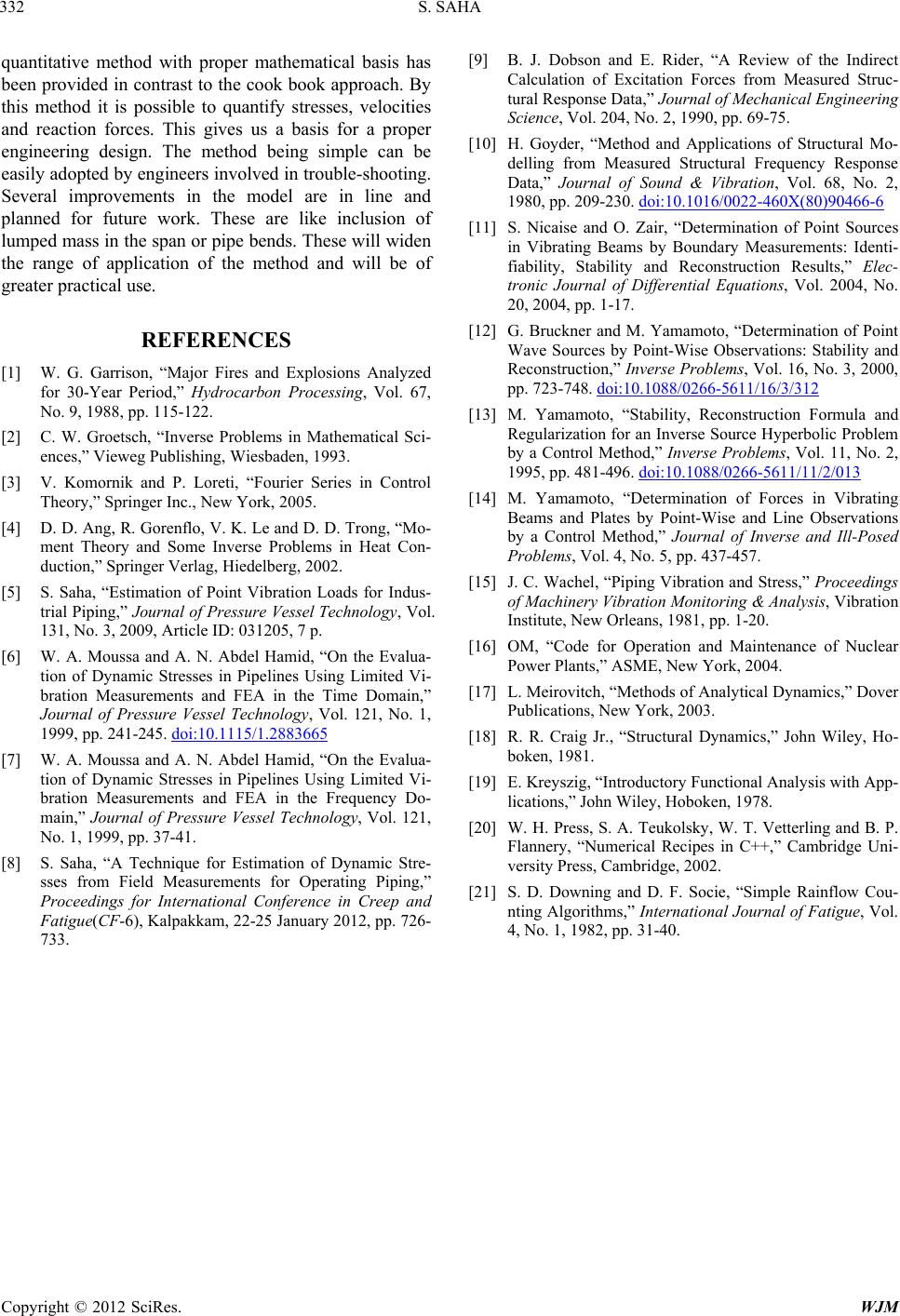
S. SAHA
Copyright © 2012 SciRes. WJM
332
quantitative method with proper mathematical basis has
been provided in con trast to the cook book approach. By
this method it is possible to quantify stresses, velocities
and reaction forces. This gives us a basis for a proper
engineering design. The method being simple can be
easily adopted by engineers involved in trouble-shooting.
Several improvements in the model are in line and
planned for future work. These are like inclusion of
lumped mass in the span or pipe bends. These will widen
the range of application of the method and will be of
greater practical use.
REFERENCES
[1] W. G. Garrison, “Major Fires and Explosions Analyzed
for 30-Year Period,” Hydrocarbon Processing, Vol. 67,
No. 9, 1988, pp. 115-122.
[2] C. W. Groetsch, “Inverse Problems in Mathematical Sci-
ences,” Vieweg Publishing, Wiesbaden, 1993.
[3] V. Komornik and P. Loreti, “Fourier Series in Control
Theory,” Springer Inc., New York, 2005.
[4] D. D. Ang, R. Gorenflo, V. K. Le and D. D. Trong, “Mo-
ment Theory and Some Inverse Problems in Heat Con-
duction,” Springer Verlag, Hiedelberg, 2002.
[5] S. Saha, “Estimation of Point Vibration Loads for Indus-
trial Piping,” Journal of Pressure Vessel Technology, Vol.
131, No. 3, 2009, Article ID: 031205, 7 p.
[6] W. A. Moussa and A. N. Abdel Hamid, “On the Evalua-
tion of Dynamic Stresses in Pipelines Using Limited Vi-
bration Measurements and FEA in the Time Domain,”
Journal of Pressure Vessel Technology, Vol. 121, No. 1,
1999, pp. 241-245. doi:10.1115/1.2883665
[7] W. A. Moussa and A. N. Abdel Hamid, “On the Evalua-
tion of Dynamic Stresses in Pipelines Using Limited Vi-
bration Measurements and FEA in the Frequency Do-
main,” Journal of Pressure Vessel Technology, Vol. 121,
No. 1, 1999, pp. 37-41.
[8] S. Saha, “A Technique for Estimation of Dynamic Stre-
sses from Field Measurements for Operating Piping,”
Proceedings for International Conference in Creep and
Fatigue(CF-6), Kalpakkam, 22-25 January 2012, pp. 726-
733.
[9] B. J. Dobson and E. Rider, “A Review of the Indirect
Calculation of Excitation Forces from Measured Struc-
tural Response Data,” Journal of Mechanical Engineering
Science, Vol. 204, No. 2, 1990, pp. 69-75.
[10] H. Goyder, “Method and Applications of Structural Mo-
delling from Measured Structural Frequency Response
Data,” Journal of Sound & Vibration, Vol. 68, No. 2,
1980, pp. 209-230. doi:10.1016/0022-460X(80)90466-6
[11] S. Nicaise and O. Zair, “Determination of Point Sources
in Vibrating Beams by Boundary Measurements: Identi-
fiability, Stability and Reconstruction Results,” Elec-
tronic Journal of Differential Equations, Vol. 2004, No.
20, 2004, pp. 1-17.
[12] G. Bruckner and M. Yamamoto, “Determination of Point
Wave Sources by Point-Wise Observations: Stability and
Reconstruction,” Inverse Problems, Vol. 16, No. 3, 2000,
pp. 723-748. doi:10.1088/0266-5611/16/3/312
[13] M. Yamamoto, “Stability, Reconstruction Formula and
Regularization for an Inverse Source Hyperbolic Problem
by a Control Method,” Inverse Problems, Vol. 11, No. 2,
1995, pp. 481-496. doi:10.1088/0266-5611/11/2/013
[14] M. Yamamoto, “Determination of Forces in Vibrating
Beams and Plates by Point-Wise and Line Observations
by a Control Method,” Journal of Inverse and Ill-Posed
Problems, Vol. 4, No. 5, pp. 437-457.
[15] J. C. Wachel, “Piping Vi bration and Stress,” Proceedings
of Machinery Vibration Monitoring & Analysis, Vibration
Institute, New Orleans, 1981, pp. 1-20.
[16] OM, “Code for Operation and Maintenance of Nuclear
Power Plants,” ASME, New York, 2004.
[17] L. Meirovitch, “Methods of Analytical Dynamics,” Dover
Publications, New York, 2003.
[18] R. R. Craig Jr., “Structural Dynamics,” John Wiley, Ho-
boken, 1981.
[19] E. Kreyszig, “Introductory Functional Analysis with App-
lications,” John Wiley, Hoboken, 1978.
[20] W. H. Press, S. A. Teukolsky, W. T. Vetterling and B. P.
Flannery, “Numerical Recipes in C++,” Cambridge Uni-
versity Press, Cambridge, 2002.
[21] S. D. Downing and D. F. Socie, “Simple Rainflow Cou-
nting Algorithms,” International Journal of Fatigue, Vol.
4, No. 1, 1982, pp. 31-40.